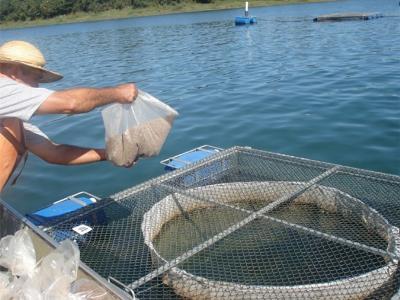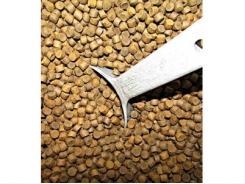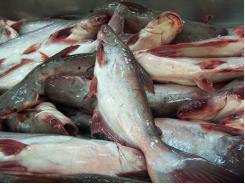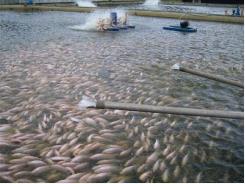Aiding gut health with a natural growth promotor

Study shows improved productivity and profitability in cage-farmed tilapia in Brazil
Feeding the tilapia during the trial.
In Nile tilapia (Oreochromis niloticus) farming – as in all fed aquacultured species – feed accounts for 60 percent of the total production costs. Increasing prices of raw materials has led nutritionists to search for alternative ingredients to reduce or at least maintain feeding costs. Meanwhile, as aquaculture production continues to intensify, disease is putting more pressure and presenting more obstacles to profitability. Best farming practices – including biosecurity, husbandry and functional feeds, adapted to each specific fish species and production challenge – are key for the optimal and profitable development of the industry.
The search for functional feeds that enhance digestive capacities and robustness against diseases is a major goal for the aquafeed industry. In this regard, additives capable of promoting a stable and healthy gut microbiota have the potential to impact directly on the digestive efficiency of fish and result in effective natural growth promotion. Furthermore, better gut health forms a natural barrier against pathogenic infections entering via the digestive tract and boosts the overall immune status of the fish, leading to higher resistance to disease. Results in marine fish and shrimp demonstrated the positive effects of gut health promotors on performance and profitability in field conditions (Chamorro et al., 2011; Tzouramanis et al. 2012; Valle et al., 2015). In this study, we evaluated the effect of a gut health promoting additive on the production parameters of tilapia reared in cages in Brazil.
The cage culture trial
The study was carried out with Nile tilapia (Oreochromis niloticus, GIFT strain), including the processing of commercial size fish, and was carried out by the Fisheries Institute (Instituto da Pesca) in collaboration with a commercial tilapia integration in the Sao Paulo Region of Brazil. The study lasted 111 days, starting with 170-gram fish and until harvest at a commercial size of approximately 750 g. The cages used to grow the fish were 7 square meters each, and were stocked with 840 fish each. All fish were counted and weighed, and then were randomly distributed into the different replicate cages (five cages per treatment). Prior to the start of the trial, the animals were fed with a commercial diet (36 percent CP, crude protein). Standard water quality parameters were monitored during fish acclimatization and throughout the trial, with rather low temperatures during acclimatization. Water temperature, pH and dissolved oxygen remained within acceptable ranges for tilapia production during the trial (Fig. 1).
The control feed was a 32 percent CP, commercial floating diet, and the treatment feed consisted of the same commercial diet formula incorporating a natural growth promotor based on a double mode of action, i.e. modulation of the microbiota (inhibiting growth of pathogenic bacteria and promoting growth of beneficial bacteria) and quorum sensing inhibition (SANACORE® GM, Nutriad) at an inclusion of 1.5 kilograms per metric ton of feed.


Fig. 1: Water temperature, dissolved oxygen and pH levels during the trial.
The feed was prepared in a commercial extrusion feed line, and the additive was added in the mixer with the rest of the ingredients prior to cooking-extrusion. The animals were fed four times per day until they reached 170 g, and once the trial started, animals were fed three times per day. Any non-consumed feed was recovered and counted. No differences in terms of appetite were detected during the trial due to feed type. At the end of the trial, all fish were harvested, counted and weighed, and 5 percent of the animals in each treatment were checked and evaluated for their viscero-somatic indexes.
Better performance and reduced visceral fat deposition
At harvest, the group fed the diet supplemented with the gut modulator showed significantly improved production parameters compared to the control, including a 4.7 percent increase in survival, 2.8 percent higher average final weight, 6.7 percent better FCR and 6.7 percent lower feed consumption. Overall, the harvested biomass was 7.7 percent higher for the treatment group relative to the control (Table 1; Fig. 2).
Goncalves, Table 1
| Parameter | Control | Sanacore GM | % change vs. control | P value |
| Survival (%) | 92.1 | 96.4 | 4.7 | 0.048 |
| FCR | 1.72 | 1.60 | -6.7 | 0.019 |
| Daily weight gain (g/day) | 4.93 | 5.05 | 2.5 | 0.165 |
| Average final fish weight (g) | 714 | 734 | 2.8 | 0.021 |
| Harvested biomass (% of control) | 100 | 107.7 | 7.7 | - |
| Feed intake as % ABW/d | 3.09 | 2.89 | -6.7 | 0.019 |
Effect of a gut health promotor on production parameters of tilapia. P value < 0.05 shows statistically significant results.


Fig. 2: Effect of a gut health promotor on FCR and survival of tilapia. P value < 0.05 shows statistically significant results, indicated with the symbol
The fish fed the gut health promotor had 8.4 percent lower visceral fat deposition, as well as improved viscero and hepato-somatic indices (minus-6 and minus-12 percent, respectively) (Table 2).
Goncalves, Table 2
| Control | Sanacore GM | % change vs. control | |
| Visceral fat (%) | 4.76 | 4.36 | -8.4 |
| Viscero-somatic index (VSl. %) | 8.84 | 8.29 | -6.2 |
| Hepato-somatic index (HSl. %) | 1.07 | 0.94 | -12.1 |
Effect of a gut health promotor on visceral fat and viscero/ hepato-somatic indices.
Economics
The use of functional feed additives to promote growth and/or disease resistance has been demonstrated with different aquaculture species in controlled laboratory studies. However, demonstrating the commercial cost efficiency of these strategies requires field evaluations under the specific challenges encountered in production. During the current field trial, conditions were favorable and there were no disease outbreaks during the growout, resulting in an excellent survival at harvest (control cages averaged 92 percent survival). Despite the excellent productivity in the control cages, the gut health promotor promoted a significant improvement of survival, growth and food conversion, resulting in an overall improvement of productivity of 7.7 percent. The economic analysis showed that the feed additive resulted in 9.9 percent increased revenues for the farmer and a return on investment of 2.2.
Goncalves, Table 3
| Parameter | Relative Improvement of treatment versus control |
| Fish produced (MT) | 7.7 |
| FCR | -6.7 |
| Feed price (incl. additive) R$/MT | 3.8 |
| Additional revenue (R$) | 9.9 |
| Feed cost (R$ per kg of fish) | -3.5 |
| ROI | 2.2 |
Effect of a gut health promotor on farm economics in cage farmed tilapia.
Perspectives
The results obtained in this study confirm previous results on the use of gut health promotors in other aquaculture species in the lab and in field trials for tilapia farmed in cages. This study shows the potential of this type of feed additives as a growth promotor in the cage growout of tilapia in the absence of major disease threats. Further work is underway to investigate the impact on survival in production conditions where disease pressure is affecting fish health and farm productivity.
Related news
Tools

Phối trộn thức ăn chăn nuôi

Pha dung dịch thủy canh

Định mức cho tôm ăn

Phối trộn phân bón NPK

Xác định tỷ lệ tôm sống

Chuyển đổi đơn vị phân bón

Xác định công suất sục khí

Chuyển đổi đơn vị tôm

Tính diện tích nhà kính

Tính thể tích ao









 U.S. universities collaborate on antibiotic…
U.S. universities collaborate on antibiotic…  Risk v. hazard: A dispassionate…
Risk v. hazard: A dispassionate…